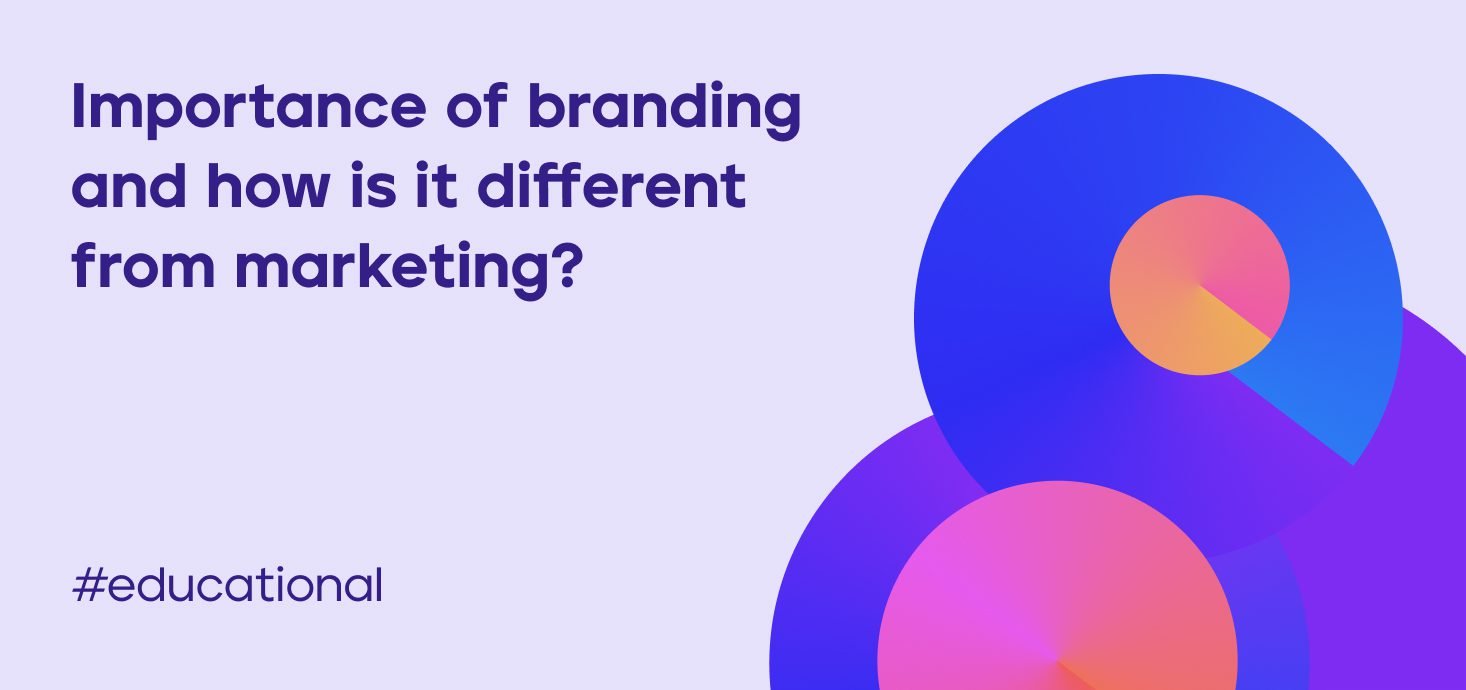Marketing is a highly dynamic sector today as it depends mainly upon the consumers. With changing consumer behaviors and their shifting preferences, marketing changes too. This is because it’s all about what your consumers desire and whether you, as a provider, are able to touch their pain points and leverage them or not. This is true that as a marketer or a business, you can nail a project by just being abreast with your consumer and their expectations of you. But it is also true that external forces like increasing competitors, changing behavioral patterns and needs, and innovations have made this difficult or hard-to-achieve goal.
This is why marketing today is so much more than billboards. Considering which it is digestible that people sometimes mix branding with marketing, thinking that they both aim to put the product out to the audience. To be precise, branding is integral to marketing; it comes before marketing and helps establish a brand identity and persona before you strategize how you will market your product/service.
But that’s not it. Let’s dig deep into the concept of branding and follow it up with the differences between marketing and branding to understand it better.
The concept of branding-
Branding helps any business create a brand perception. The purpose of branding is to differentiate your brand from the competitors in the industry. This is done by working on different elements like typography, visuals, color palettes, brand promise, and more. As your business grows and builds a brand persona for itself, people start recognizing it for your unique brand positioning.
As a brand, your audience will expect a similar brand tone at every touchpoint, be it online via emailers and social media or offline (in-store). So your brand’s objective shouldn’t be restricted to creating a visual identity but should extend to creating a striking impression for your audience. So they know what they can expect from your brand.
Now that we have understood branding, let’s go ahead and talk about some critical differences between branding and marketing for a better understanding.
How is branding different from marketing?
The only reason you need to understand the difference between the two precisely is that you aim to maximize conversions as a business or a marketer. To do that, you need to know this:
- Grabbing attention today is getting more difficult as the competition increases but retaining that attention is even more back-breaking. Marketing helps you stand out from the crowd, while branding becomes essential for retention.
- The purpose of marketing is to promote the products or the services to drive sales, whereas, through branding, a business establishes a strong foothold in the industry and gains recognition as a credible merchandiser.
- Branding is the first step, followed by marketing strategies and action plans. Branding is fundamental, yet people sometimes choose to skip the process and start advertising straight away.
In a nutshell: “Branding helps you build your business values and brand messages, whereas, marketing is the tool that helps convey the same to the ideal prospects.”
Significance of branding-
-
Quick brand identification
Branding makes your brand easily recognizable in the market. The designs, logo, and color palette that you will choose for your products will create a visual identity of your brand in the minds of your customers. This helps the customer in their buyers’ journey as there is always a better probability of a person purchasing from a recognizable brand than an oblivious one.
For an easily recognizable brand, it is pertinent to deliver a strong brand message that describes your purpose as a brand and educates your customers of the benefits that your business values can provide to them through visuals that follow brand guidelines- so you can be remembered.
-
Edge over industry players-
The digital decade has opened new realms of entrepreneurship. With the growing number of businesses, consumers are also becoming more aware of their needs and becoming even pickier. To please such a finical audience, you need an even better and more intricate branding strategy to set you apart from the competition. With consistent branding initiatives across different customer touchpoints, your brand can separate itself from competitors and boost sales.
In 2022: “A brand will always stand above a business.”
-
Committed customers-
What else can effective and well-strategize branding do for you? It can earn you a loyal customer base! When you portray your brand as one that keeps up with its values and beliefs, consumers will be attracted to your brand and think of it as a credible name in the industry. Approximately 78% of B2B marketers have leveraged their client base and generated warm leads through referrals. This is because consumers today like brands they can resonate with on an emotional level. Hence, your brand message has to be strong enough, so it triggers a deep connection with your audience.
-
Better retention rate-
“80% of businesses’ future profits come from 20% of their existing customers.” This statement alone should tell you the importance of client retention as a business. Branding has a pivotal role to play in this because marketing strategies focus on attracting a new client base, but branding is what retains.
Build a high converting branding strategy for your business-
-
Reflect on your businesses’ strategy
Your goals, endeavors, and action plans are a few elements of your business strategy, which is the core framework of your branding strategy. This is so because, to build an effective branding strategy, your first requirement is to know your business’s direction clearly.
Look into your goals and visions in detail and jot down a few things you would like to achieve or work upon in the coming years. Having a clear picture of your business objectives will help you create a branding strategy that supports your business’s ultimate vision.
2. See where you stand.
If you’ve been in the market for some time now but have just realized the need for a strong brand presence, you will have to review your current brand strategy.
You need to assess what you’ve been conveying to your consumers at different touchpoints to understand your consumers’ perception of you. And from here, it is up to you to build further upon these values or divert from them by changing your strategies altogether.
3. Understand your target audience
Your target audience is who you serve as a business, and without knowing them in and out, you can not develop an effective marketing and branding strategy.
Creating a buyer persona includes everything from their age and gender to their income, likes-dislikes, habits, and more. At this step, you try to get as much information about your target audience as possible so that you can leverage the same later on.
Having in-depth knowledge about your ideal client will help you devise strategies that will connect to them directly and help you build a more relatable brand for your audience.
4. Understand your mission and vision
Both, your mission and vision statement are a part of your business’s value proposition since it states your goals and endeavors respectively to your audience and ensures that both are in complete alignment.
The vision statement of your brand will dictate your company’s aims and objectives- a short but bold statement that communicates your company’s long-term goals and its way forward. In contrast, the mission statement should be able to explain your endeavors to reach your goal.
Your mission statement must answer these questions-
- The current operations of your company.
- Your business process and purpose.
- How do you help your customers?
5. Analyze competition
At this point, you’re pretty much aware of how you want to position your brand in the market. However, before actually moving on to that part, you should finally take a step back to see what others in your industry are doing and how consumers respond to their brand.
You could take inspiration from them or try to fix things they’re doing wrong. Since your competitors are already established, you can learn a lot from them and make sure your brand appears as the one consumers want to deal with.
6. Brand positioning
It’s not about how appealing your brand looks; it’s about how different it is so it stands out for your target audience and stays with them. A strong brand positioning strategy will differentiate a brand from its competitors.
You can provide a seamless customer experience or practice convenience that others might not be doing.
7. Brand identity
Many people confuse brand identity for the visuals; while that is a big part of building a brand identity, one can not forget that it’s the brand message conveyed through these visuals that eventually forms your brand’s identity.
Once done right, it sets the tone and message of your brand right, which is then conveyed to your target audience consistently through different mediums and touchpoints. Your branding must convey a strong message that leaves indelible imprints on your audience.
8. Align your content marketing strategy
Contrary to how things were before, today’s marketing world has found its way out of traditional television advertisements. Today, consumers like to be provided value; and marketers do that through content.
From youtube videos to podcasts, social media posts, and articles- there are so many forms of valuable content that you can feed your target audience to build the trust they need to rely on you.
Building an efficient content marketing strategy is vital for your bottom line. Moreover, it’s cheaper to implement but brings better results than other expensive marketing methods.
9. Create a website, increase social media visibility
You need to customize every touchpoint of your customer’s buying journey with a similar brand message. Since your website and social media are two significant touchpoints, you need to maintain a similar brand message and tonality.
Moreover, your website is another tool for marketing yourself as a brand in the industry since it helps your company’s visibility on Google. Thus, a website is non-negotiable.
10. Audit and review
Finally, keep reviewing! Once implementation is done, your job doesn’t end there. You need to keep close tabs on the numbers. Analyze what brought you leads and results and what didn’t. And tweak your strategy accordingly.
The industry is dynamic, and what brings you results today might not be as effective tomorrow. So the key is to keep reviewing and adjusting with time.







